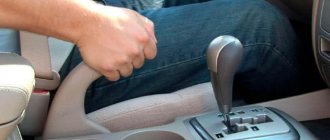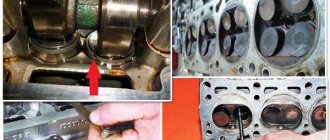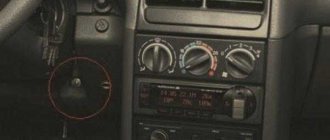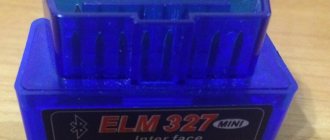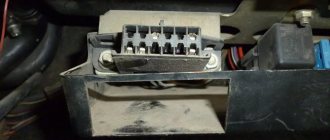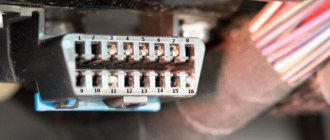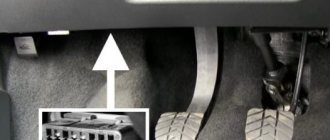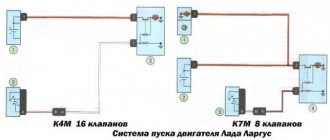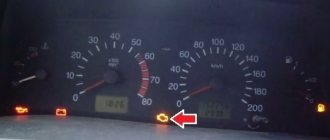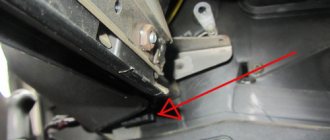07/07/2018 Category: Car diagnosticsAuthor: admin
The unified standard that regulates vehicle diagnostic parameters and provides access to its systems is OBD 2 . It determines the type and location of the diagnostic connector pins, error and information exchange protocols, and command system standards. In the article we give a detailed description of the OBD2 diagnostic connector.
- 1 Evolution of the OBD2 diagnostic connector
- 2 OBD2 standard interface
- 3 Standard OBD2 connector
- 4 Stages of car diagnostics using OBD2
Evolution of the OBD2 diagnostic connector
Already in the late 70s of the last century, when cars first began to be equipped with electronic units, manufacturers began to take steps to develop and implement self-diagnosis systems and connectors for connecting test equipment.
Since then, the share of electronics in the overall design of a car has grown from 4-5% to today's 40%. Detecting breakdowns and malfunctions without connecting testing equipment is not possible. Therefore, the electronic units were equipped with connectors for connecting diagnostic devices.
The first serious prototype of the current OBD2 connector was the universal ALDL protocol, developed by General Motors in the 1980s. In the early 90s, under the pressure of legislatively established atmospheric emissions standards, the OBD1 protocol was developed in the USA. Its compliance has become mandatory throughout the United States, but has not yet regulated the type and location of the connector, as well as error protocols.
With the emergence of new players in the auto manufacturing market, the problem of vehicle maintenance has arisen due to the incompatibility of diagnostic equipment with their on-board electronic systems. The universal diagnostic connector solved this problem and allowed new car manufacturers to compete with well-known brands.
Just five years later, in 1996, the OBD2 standard for connectors was introduced, which spread throughout the world and became mandatory for European automakers in 2000.
In Europe it was transformed into EOBD2, in Japan - JOBD2. The OBD-III standard is currently being developed.
Deciphering error codes
One of the main advantages of the OBD2 protocol is the unification of fault coding, which guarantees the same interpretation regardless of the make/model of the vehicle. The structure of the fault code is shown in the following figure:
As a rule, when the scanner displays detected errors, it also indicates a description of the malfunction along with the code. And based on the code and description of the error, you can try to search the Internet for ways to troubleshoot the problem by entering the error code and the name of your car into a search engine. Car service workers are generally well aware of what each error means and what needs to be done to correct it. But car enthusiasts should be careful: information gleaned from specialized forums and other automotive resources may contain errors or inaccuracies that may affect the results of self-repair, so the best way to solve the problem is to search and watch relevant videos.
OBD2 standard interface
Firstly, the concepts of “OBD2 connector” and “OBD2 interface” should be clearly distinguished.
The interface is all the “stuffing”, all aspects, including the connector itself, that affect a set of standards. These aspects include:
- Shape, assembly diagram, pinout, connections and location of the connector;
- Standards of executive and control commands, order and form of data exchange, message format, supported programs;
- Type and priorities of communication.
At its core, the interface characterizes the software with which OBD2-type diagnostic devices operate. All functions programmed in it are consistent with OBD2 standards.
Now, on the Internet, you can find many utilities with the help of which OBD2 test devices work with personal devices on different platforms (IPhon, Microsoft, Android).
The leader in popularity is OBD-2 iPhone Application - prof. application for iPhone and iPad, designed for car diagnostics using OBD2 and ELM327 equipment. The main indicator of its popularity is its mobility. Scanners and autotesters with this software connect to both Apple computers and laptops, as well as smartphones and tablets. This makes it possible to test anywhere and in any situation. And real-time tracking features turn your phone into your car's remote control.
The DashCommand and Torque applications have become widespread; their clear interface and ease of use have won the sympathy of many car owners.
Before the advent of mobile phone apps, Windows utilities almost reigned supreme in the diagnostic realm. Among them, ScanTool and MyTester are still particularly popular. However, fewer and fewer users give their preference to PC utilities.
But there is one significant advantage of such software - this is a high degree of security of both the PC itself and the on-board computer from outside (hacker) interference. The reason lies in the connection method. Mobile applications communicate wirelessly (Wi-Fi and Bluetooth), and the PC connects via a USB port. In the first case, any gadget with a similar program that is within wireless range can gain access to your car and PC. Whereas, in the case of communication via USB, in order to log into your system, he needs to sit in your place in front of the computer.
Adapters available on the market
The modern market offers a large selection of adapters that allow you to diagnose a car via a laptop.
Main types:
- ELM OBD2 are easy-to-use scanners running on the ELM 327 chip, designed for independently reading machine errors and eliminating them without visiting a service station. The original adapters of this series come with a Microchip PIC18F25k80 microprocessor, a software disk, a list of faults and diagnostic lessons.
- VAG COM adapters are devices designed to test German cars of the VAG group. Such devices are used by professionals at service stations, but can also be used by ordinary car owners in a garage. It is enough to install the necessary program on your computer.
- Multi-brand scanners are universal devices that can cope with checking most modern car brands. During diagnostics, you can check and erase fault codes, reset service intervals, display system characteristics, encode the ECU and activate a special mode, and study the status of actuators. In addition, they can be used to simulate commands from sensors and monitor changes in the system.
Launch Creader 3001 RUS - Dealer scanners are a professional version of devices for car diagnostics, allowing you to perform a comprehensive check. Such auto scanners only work with cars of a certain brand.
iCarsoft i905 – car scanner for Toyota / Lexus
As you can see, the market for automotive diagnostic scanners is very wide. However, not all equipment is suitable for independently checking a car in a garage.
Standard OBD2 connector
- Form. Until 2003, there was no strict standard for the shape of the connector. Each manufacturer himself determined what shape the connectors on his cars would be. Later, under the pressure of market laws (cars with a certain connector shape were in great demand), a standard was developed defining its trapezoidal shape. It has a 16-pin header, where the pins are arranged in two rows (8 contacts each). An output is provided here that will provide power to diagnostic instruments from the vehicle battery, eliminating the need to separately connect to the power source.
There are two types of standard connectors - type A and type B. Both consist of two rows of contacts with a groove between them. In type B it is interrupted in the middle. This is necessary to prevent the connection of an A-type plug (for cars with an on-board voltage of 12V) to a B-type socket (for a car with a 24V voltage). Reverse connection is allowed.
- location . The standard does not define the exact location, but the distance from the steering wheel, which is no more than 1 meter. This could be under the dashboard, under the ashtray, under the console or handbrake, or in the armrest.
- Pinout . The purpose of the contacts is regulated by the SAE J1962 protocol. They are numbered from #1 to #16. Contacts No. 1,3,8,9,11,12,13 are loaded by manufacturers according to their needs. Usually electronic units are connected to them (ABS, SRS, boxes, bodies, etc.)
The remaining contacts are subject to strict installation regulations.
- No. 2 – line J1850
- No. 4 – mass
- No. 5 – earth
- No. 6 – high level CAN – buses
- No. 7 – K-Line channel
- No. 10 – channel J1850
- No. 14 – CAN line low level
- No. 15 – K-Line
- No. 16 – positive battery contact
- The connection is made with equipment, with a connector combined with OBD2. If there is none, adapters are used. You can buy them or assemble them yourself.
- Connect the scanner to the car ECU connector and to a personal device on which the software for your device is already installed. The connection can be via a USB port or wireless channels.
- Turn on the ignition (in some cases it is necessary to start the engine).
- In the program settings, find and enable Bluetooth or WI-FI.
- By clicking “search for devices”, select the name of your OBD scanner from the options provided. Enter the identification code (from the technical documentation of the device or from the label). Usually these are 1234 or 0000 and 6789.
- Pairing has occurred, but the “not connected” message appears on the screen.
- Go to the settings again, find the “Select Bluetooth device” item in “OBD2 adapter settings” and activate the line with your scanner in it.
- Return to the main screen and begin diagnostics.
OBD-2 adapters and extensions existing on the market
Using OBD-2 adapters, car diagnostics are available using modern devices without an OBD connector.
The devices are suitable for Audi, Honda, Mercedes Benz, Audi, Opel, Nissan, Mitsubishi, VAZ and others.
The main types of adapters are listed below.
- GM12 pin - OBD2. Suitable for Chevrolet, Daewoo, ZAZ and VAZ cars.
- GAS 12 pin - OBD2. Suitable for UAZ and GAZ cars, 12 contacts are used.
- AutoCom adapter set for passenger cars. For people who are professionally involved in diagnostics, a set of equipment may be useful; it includes the following set - VAG 2 2 pin -> OBD-2 (for Audi, Skoda, Seat and Volkswagen), BENZ 38 pin -> OBD-2 (for Mercedes Benz ), BMW ADS 20 pin -> OBD-2 (for BMW), FIAT 3 pin -> OBD-2 (for Alfa Romeo, Fial and Lancia), OPEL 10 pin -> OBD-2 (for Opel), PSA 2 pin -> OBD2 (for Peugeot and Citroen), PSA 30 pin -> OBD-2 (for Peugeot and Citroen).
- AutoCom adapter set for trucks. The package includes a 7 pin Knorr Wabco Trailer Cable, as well as other components - 12 pin MAN Cable, pin IVECO Cable, 16 pin SCANIA Cable, 12 pin Renault Cable, 8 pin VOLVO Cable, 37 pin MAN Cable, BENZ Cable.
- VAG 2×2 – OBD-2. Suitable for VAG cars manufactured before 1997. The package includes two chips - diagnostic lines K and L, as well as 12 V power supply with ground. Each of the chips is signed and has markings to prevent incorrect connection.
- Kia 20pin – OBD-2. Used for diagnosing Kia cars. Has 20 connectors. The connector itself is located in the engine compartment. In some models you can use the ELM327 scanner, but using the mentioned adapter.
- Ford 7pin - OBD-2 - for diagnosing Ford, Lincoln and Mercury cars. Mainly used for older Ford cars manufactured between 1985 and 1995.
- Mercedes 38 pin – OBD-2 – is intended for diagnosing Mercedes cars that came off the assembly line between 1994 and 2002. Has 38 pins per connector.
- Mercedes 14 pin - OBD-2 - apron with 14 pin connector for OBD-2. Designed to test Volkswagen, Mercedes Benz (Sprinter, Actros and Atego) cars.
- Nissan 14 pin - OBD-2 - a device for diagnosing old Nissan cars with a 14-pin socket.
- Toyota 22 pin Japan - OBD-2 - adapter for diagnosing cars produced on the Japanese market before the advent of the OBD-2 standard.
- Toyota 17 pin – OBD-2 – used for Toyota cars with a 17-pin OBD diagnostic connector.
- BMW 20 pin – OBD-2 – helps in diagnosing BMW cars manufactured before 2022.
- Honda / Acura 3 pin - OBD-2 - adapter for cars from the manufacturer Acura and Honda that have a 3-pin connector. Its purchase allows you to diagnose older models.
- Honda / Acura 5 pin – OBD-2 – used for diagnosing Honda cars of an earlier model range. Suitable for connecting a car with 16 contacts to models with a 5-pin connector.
- Subaru 9 pin - OBD-2 - used for Subaru cars and provides a transition from a 9-slot to a 16-slot group. This type of OBD was installed on Subaru produced in the period 1993-2001.
- Renault 12 pin – OBD-2 is an adapter that allows you to connect a scanner between a car with 12 and 16 pins. Suitable for checking Renault cars.
- Mazda 17 pin – OBD-2 – suitable for diagnosing Mazda cars with a 17-pin connector. With its help, you can safely use modern scanners.
- Mitsubishi / Hyundai 12 pin - used for Hyundai and Mitsubishi cars produced in the period 1989-1998. They have a block with 12 contacts.
- Opel / Vauxhall 10 pin – OBD-2 – designed for diagnosing Vauxhall and Opel. Cars must be produced before 1996. Their peculiarity is the presence of a rectangular connector with 10 contacts.
- Fiat, Lancia, Alfa Romeo 3 pin - OBD-2 - used for cars of the Alfa Romeo, Lancia and Fiat brands that have a 3-pin socket, as well as alligator clips for external power.
- Peugeot, Citroen 30 pin - OBD-2 - designed for diagnosing Citroen and Peugeot that came off the assembly line before 1997.
- Cummins 9 pin (KAMAZ, KAVZ, PAZ) – OBD-2 – used for diagnosing KAVZ, KAMAZ and PAZ vehicles. Provides transition from 9 to 16-pin connector.
- Volvo 8 pin – OBD-2. Adapter for use on Volvo trucks with an 8-pin block.
- Iveco 30 pin – OBD-2 – used to connect equipment from a 30-pin to a 16-pin connector. Used for diagnosing Iveco cars.
- SCANIA / DAF-16 pin is a convenient tool that provides a transition between old Scania or DAF pads to new types of connectors for diagnostic work.
- OBD-2 1.5 meters - a 1.5 m extension cable designed to connect the connector to the scanner.
- OBD2 20 cm is another extension cord designed for use in conditions of limited access to the connector. There is wiring for all 16 contacts.
- Adapter from OBD-2 to RS232 COM.
The list of adapters and extension cords is wide enough to choose the best option and diagnose cars of different brands and years of manufacture with your own hands.
Stages of car diagnostics using OBD2
- Available functions and final diagnostic result
The available functions largely depend on the capabilities of the ECU and PC. Therefore, the same scanner on different car models will have different capabilities.
Main diagnostic functions via OBD2:
- Scanning of individual electronic units and the entire system as a whole;
- Reading codes and outputting a report with decrypted error codes. The report can be provided in the form of a graph or a list;
- Resetting errors - deleting stored error codes from the ECU memory. This must be done after troubleshooting;
- Ability to view and adjust parameters in dynamic mode. Monitoring current sensor readings;
- Some special functions - adaptation, programming, coding, etc.
Of course, this is not all the functionality of OBD2 diagnostics. There are many interesting and useful functions. Each software has its own functionality and a set of tools for their use.
- Testing algorithm
- The scanner is connected, communication is established. In the program, select the model of your car. And we start testing;
- Based on the scanning results, a report is displayed. The codes are displayed with explanations. Write them down on a piece of paper. Some programs allow you to send a report to print. Take advantage of this feature;
- Next we reset the codes;
- Turn off the engine. After 10 - 15 minutes, start the engine again and preferably drive a little, turning and picking up speed. This way we help the ECU acquire movement data, since all the previous ones have been erased (we train);
- Scan again and compare with previous results. Repeatedly displayed error codes will be reset after the corresponding problem is resolved;
- You can then adjust the operation of some components. For this purpose, scanners and their programs provide a real-time viewing function. The list of what can be changed will be provided by the software on the PC monitor and depends on the characteristics of the car’s on-board computer software.
- Decoding the code
Most diagnostic software provides access to manufacturer databases. In them you can find a detailed decoding of the code, taking into account the characteristics of your car model. Information can also be found in the public domain by entering in the search bar the code and make of the car, as well as the year of manufacture and engine size.
- Self-diagnosis precautions
- The battery must be sufficiently charged and the contacts are firmly connected.
- First remove all breaks and restore the electrical network (if there were any disconnections).
- Turn on all electrical appliances connected to the on-board network (including the scanner) after starting the engine. Possible power surges can damage them.
- Choose licensed software for autotesters from trusted manufacturers. A low-quality product may harm the on-board electronic system.
- Without complete confidence in full understanding, do not use special functions or make adjustments to the ECU software.
The on-board computer controls all processes in the car. This is a very accurate and sensitive device. Incorrect intervention will inevitably lead to its failure. This is too expensive. Therefore, always take precautions.
Connecting scanners to a non-standard connector
The OBD2 connector pinout diagram provides for the use of specific buses for specific purposes, but some automakers, adhering to the standard pinout, do not comply with the generally accepted connector format. This is especially true for freight vehicles, but you can often find passenger cars (in most cases, manufactured before 2000) in which the diagnostic connector has a non-standard appearance. In such cases, they resort to using appropriate adapters, which are quite difficult to find in regular car stores, but easy to find on the Internet. If it is difficult to purchase a suitable adapter, it is enough to have a pinout diagram for the OBD connector of your vehicle in order to make it yourself (if you have skills in handling a soldering iron and knowledge of basic electrical engineering). Again, a diagram for reconnecting the contacts of the diagnostic connector can be found on the Internet.
For professional car services, it is better to use adapter sets, which include from six to two dozen different adapters. When using them, the non-standard connector of the adapter is connected to the OBD port of the ECU, the second connector is connected to the diagnostic cable port (as an option, directly to the scanner). There are also situations when the use of an adapter does not allow diagnostics due to the fact that the ECU simply does not support operation using the OBD protocol. In this case (we are talking about older cars), you should look for an appropriate scanner.
LAUNCH CREADER V+
Not the cheapest and not the most accurate scanner among those suitable for non-professional use. But at the same time, it attracts the attention of many motorists because it has its own display. To use it, you do not need to connect to a smartphone or laptop. In addition, the data is presented in various forms, including diagrams and graphs. The device is able to recognize most typical breakdowns with minimal error. It has a fairly large number of useful and important functions. But the small display makes working with the adapter not very convenient.
Rokodil ScanX Pro
In terms of diagnostic quality, the most preferable option is the multi-brand device Rokodil ScanX Pro. In addition to OBD2, the device supports CAN, J1850PWM, J1850VPW, ISO9141 and other protocols, which allows for comprehensive diagnostics of almost any car. By pressing just one button, the scanner will instantly provide information about the condition of your car with a detailed description of the faults in Russian.
Additional functionality includes the ability to build graphs, backup data from the ECU memory, freeze frame (vehicle parameters at which the fault code was recorded), and display performance characteristics.
The scanner is completely autonomous and does not require connecting third-party gadgets. The case is reliably protected from moisture, dust and dirt. The gadget is very reliable and has virtually no significant drawbacks.
Rokodil ScanX
The quality and speed of diagnostics are the main advantages of this diagnostic adapter among competitors in the budget segment. The scanner is compatible with both domestic and imported cars that have an ODB2 connector, and comprehensive and accurate diagnostics will not ignore even the air conditioning system. Bluetooth version 4.2 provides high speed reading and visualization of information on your phone, tablet or PC.
The scanner will also help when choosing a used car - with its help you can find out the real mileage and VIN, which will protect you from unscrupulous sellers. The device is also perfect for use as an on-board computer.
A reliable element base guarantees resistance to overloads and protection of the ECU from failure. There is an on/off button on the front side, and when idle, the scanner goes into power-saving mode.
Ylsfc elm327 wifi
A Chinese-made adapter costs less than 500 rubles, promising an excellent level of diagnostics for your money. Therefore, it is popular among numerous Russian car owners. The gadget is made on a PIC18F25K80 chip with version 1.5. Connects to mobile devices using Wi-Fi. Compatible with almost any laptop and smartphone, with the exception of Apple products.
The scanner is designed for diagnosing cars of almost all brands since 1995. It is characterized by sufficient verification accuracy, high connection speed and ease of connection. It has large sizes and high-quality packaging. It is quite reliable and durable. And its main disadvantage is considered by users to be excessive heating during operation. But this minus has virtually no effect on performance characteristics.
KINGBOLEN Vgate iCar2
Quite an advanced device, which is also sold on AliExpress. Its price can reach 1000 rubles. But you can often get it cheaper. Auto scanner with chip version 2.1. can work with any operating systems. It connects to gadgets not only via Bluetooth, but also via Wi-Fi. There is a sleep mode that turns on after 30 minutes of inactivity. This prevents the car battery from draining. In addition, there is a convenient reset option.
According to the manufacturer, the scanner can check American cars older than 2001, European cars - from 2004, Japanese - from 2006, Chinese - no earlier than 2011. Russian car models are supported depending on the engine brand. But at the same time, almost all modern domestically produced cars can be diagnosed with it. As practice shows, there may be difficulties connecting to cars of some brands or models.
The gadget is considered quite reliable. It has convenient packaging to avoid damage during storage.
OBD-I vs OBD-II
Image credit: Alain Van den Hende/Wikimedia Commons
Before OBD-I, each manufacturer had its own set of OBD standards, which meant mechanics had to purchase expensive diagnostic tools for each manufacturer. OBD-I was first introduced in 1987 and began the standardization of on-board diagnostics.
It had sensors that detected emissions and could minimize them using emissions control valves. However, it had many problems and shortcomings.
As a result, in 1996, automobile manufacturers began equipping cars and trucks with an OBD-II port. All systems are basically the same, but there are slight differences. These are known as protocols and are specific to vehicle manufacturers.
There are five main signaling protocols:
- SAE J1850 PWM: Pulse Width Modulation used in Ford vehicles
- SAE J1850 VPW: Variable Pulse Width used in General Motors vehicles
- ISO9141-2: Used in all Chrysler vehicles and various European or Asian vehicles
- ISO14230-4 (KWP2000) : Keyword protocol used in various European and Asian imports, as well as Honda, Jeep, Land Rover, Subaru, Mazda, Nissan, etc.
- ISO 15765 CAN : Controller Network, used on all vehicles manufactured after 2008.
Pins 4 and 5 are used for grounding in all protocols, and pins 16 are used for power from the car battery.
Once the computer detects a problem with the engine or any other vehicle component it monitors, it will activate the Check Engine Light. Some cars also flash the engine light if the problem is very serious.
